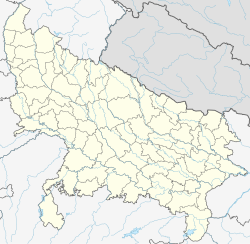Barnahal
Throughout history, Barnahal has been a topic of constant interest to humanity. From ancient times to the modern era, Barnahal has captured the attention and curiosity of people of all cultures and nationalities. In this article, we will explore in depth all facets of Barnahal, from its origins to its relevance today. Throughout the pages that follow, we will discover the importance of Barnahal in different contexts and how it has influenced the way we perceive the world around us. So join us on this journey through the fascinating world of Barnahal.
Barnahal | |
|---|---|
Village | |
| Coordinates: 27°04′36″N 78°50′21″E / 27.07654°N 78.83916°E | |
| Country | India |
| State | Uttar Pradesh |
| District | Mainpuri |
| Tehsil | Karhal |
| Area | |
• Total | 6.358 km2 (2.455 sq mi) |
| Population (2011)[1] | |
• Total | 10,203 |
| • Density | 1,600/km2 (4,200/sq mi) |
| Time zone | UTC+5:30 (IST) |
| PIN | 205261 |
Barnahal (Barnāhal) is a village and corresponding community development block in Karhal tehsil of Mainpuri district, Uttar Pradesh, India. Historically the seat of a pargana, Barnahal hosts a market twice per week. As of 2011, it had a population of 10,203, in 1,732 households.
Geography
Barnahal is located about 32 km south of Mainpuri, the district headquarters, and 16 km west of Karhal, the tehsil headquarters.[2]: 188
According to the 2011 census, Barnahal has a total area of 635.8 hectares, of which 527 were farmland and 47.8 were under non-agricultural use. 2.6 hectares were occupied by orchards, 1.3 by pastures, 4.3 were classified as cultivable but not currently under any agricultural use, and 10.6 were classified as non-cultivable. No forests existed on village lands.[1]: 130
History
Barnahal was historically the seat of a pargana under the Karhal tehsil, which had previously been known as Bibamau and before that Dehli-Jakhan (the "Dehli" refers to Dehuli, a village about 6 km south of Mainpuri). At the turn of the century, Barnahal was described as having a population of 2,461; besides the main village site, there were also 5 smaller hamlets counted as part of this total. At this point, the village had a post office, a halqabandi school, and a cattle pound, and it held markets twice weekly. The zamindar at that point was the Raja of Tirwa.[2]: 188
Demographics
As of 2011, Barnahal had a population of 10,203, in 1,732 households.[1]: 124 This population was 53.4% male (5,455) and 46.6% female (4,758). The 0-6 age group numbered 1,474 (771 male and 703 female), or 14.4% of the total population. 1,424 residents were members of Scheduled Castes, or 14.0% of the total.[3]: 100–1
The 1961 census recorded Barnahal as comprising 6 hamlets, with a total population of 3,570 people (1,712 male and 1,858 female), in 698 households and 560 physical houses. The area of the village was given as 1,571 acres and it had a post office at that point.[4]: lii
Economy
Barnahal hosts a grain market twice per week, on Mondays and Fridays.[4]: 159 There is a bank as well as an agricultural credit society.[1]: 128
Infrastructure
As of 2011, Barnahal had 6 primary schools and 1 medical clinic. Drinking water was provided by well and hand pump; there were no public toilets. The village had a post office, as well as at least some access to electricity for all purposes. There was no public library. Streets were made of a mix of both kachcha and pakka materials.[1]: 124–9
List of villages under Barnahal block
The following 89 villages are counted as part of Barnahal CD block:[1]: 122–3
- Abdulnabipur
- Agrapur
- Ahmadpur
- Ajampur
- Alamgirpur
- Alampur Deha
- Amahasan Nagar
- Andupur
- Aspura
- Aurangabad
- Bahsi
- Balpura
- Bamtapur
- Bangawan
- Barnahal (block headquarters)
- Bhagwatipur
- Bhidaura
- Bhurapur
- Binepur
- Birthua
- Chandikara
- Daloopur
- Dariyapur
- Dehuli
- Dhakpura
- Dharampur
- Garhia Jainpur
- Gaundai
- Goliyapur
- Gopiyapur
- Gotpur
- Hajipur Nera
- Hajipur Samari
- Hakimpur
- Ikahra
- Ismailpur
- Jagannathpur
- Jaitpur
- Kalanderpur
- Kalashpur
- Kanikpur Khijarpur
- Kanikpur Sada
- Karukhera
- Kasoli
- Katholi
- Kesopur
- Kharaua
- Khera Mahan
- Kherendesh Nagar
- Khushalpur
- Kumheri
- Lakhan Mau
- Longpur
- Marahamai
- Masarpur
- Mithepur
- Mohanpur
- Mugalpur
- Muhabbatpur Labhuya
- Nagla Bhai Khan
- Nagla Mandhata
- Nagla Niwhara
- Nagla Sahab
- Nawa Urf Teda
- Nitawali
- Normai
- Pahadpur
- Pairar Shahpur
- Parasrampur
- Phulapur
- Prahladpur
- Rahmatullaapur
- Rasulpur
- Rerapur
- Saiyadpur Kahari
- Saiyadpur Pran
- Sajawarpur
- Sajhajipur
- Sarai Mugalpur
- Saringa Nasirpur
- Shahjadpur
- Shahjahanpur
- Shukrullapur
- Sondra
- Sothara
- Sunupur
- Terkara Daulatpur
- Tulsipur
- Urthan
References
- ^ a b c d e f g "Census of India 2011: Uttar Pradesh District Census Handbook - Mainpuri, Part A (Village and Town Directory)" (PDF). Census of India. Retrieved 19 June 2023.
- ^ a b Neave, E. R., ed. (1929). Mainpuri: A Gazetteer, Being Volume X of the District Gazetteers of the United Provinces of Agra and Oudh. Allahabad: Government Press. Retrieved 19 June 2023.
- ^ "Census of India 2011: Uttar Pradesh District Census Handbook - Mainpuri, Part B (Village and Town Wise Primary Census Abstract)" (PDF). Census of India. Retrieved 19 June 2023.
- ^ a b Census 1961: District Census Handbook, Uttar Pradesh (24 - Mainpuri District) (PDF). Lucknow. 1965. Retrieved 25 December 2021.
{{cite book}}: CS1 maint: location missing publisher (link)
